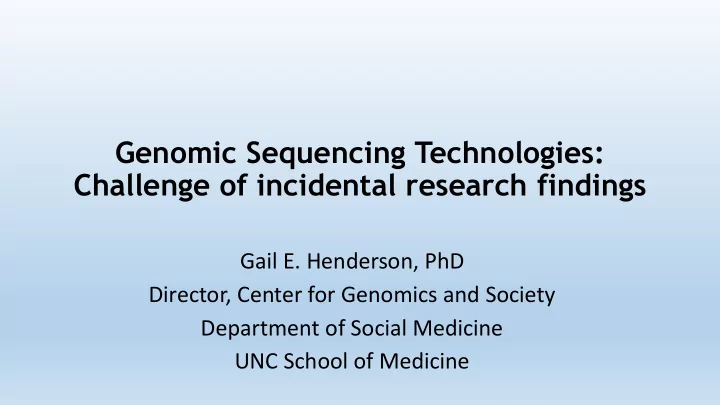

Genomic Sequencing Technologies: Challenge of incidental research findings Gail E. Henderson, PhD Director, Center for Genomics and Society Department of Social Medicine UNC School of Medicine
Genetics basically focused on looking at a few genes related to monogenic conditions With next-generation sequencing, geneticists can now look at >20,000 genes at a time, for multifactorial conditions? Sequencing focuses on certain sections of the genome for diagnosis, relying on a rapidly evolving literature
Sequencing also produces “incidental” findings, unrelated to diagnosis. Should they be returned? If you carry a rare variant that greatly increases your chances of developing a serious condition, but that can be prevented or treated, would you want to know about it ? 1. Yes 2. No 3. It depends
Historically, return of individual research results was not a standard or common practice Research is intended to produce societal not individual benefit Boundary between research and clinical care easily blurred, so must be carefully guarded
In 2013, ACMG recommended returning “actionable” incidental findings in clinical sequencing • Expert group developed list of 56 genes with known pathogenic (disease causing) variants • Rare but serious conditions like HBOC or Lynch Syndrome • Laboratory reports regardless of the indication for which the clinical sequencing was ordered. • No consent, no age restrictions • While originally focused on clinical sequencing, the recommendation to return “opportunistic” findings quickly bled into research contexts
NCGENES actionability scoring strategy Score MSH2 BRCA1 Characteristics of Threat & Treatment Sudden Death 3 Possible Death 2 2 2 Nature of threat Serious Morbidity 1 Modest/Minor Morbidity FAIL >50% 3 Likelihood of Disease 5-50% 2 3 3 (Penetrance) 1-5% 1 <1% 0 Highly Effective 3 Moderately Effective 2 Efficacy of Intervention 3 3 Minimally Effective FAIL Low Burden 3 2 2 1 Burden of Intervention 1 High Burden 0 3 3 High 3 Knowledge Base Moderate 2 Low FAIL 12 13
But genetics is not so easy as “actionable” vs. “not” • Incidental, secondary sequencing findings • By definition, rare, occurring in a population with low prior probability of disease (producing false negatives/false positives) • Variant pathogenicity • By definition, a spectrum of probabilities with arbitrary cut-offs
Genetics is not so easy as “actionable” vs. “not” • Incomplete penetrance • Likelihood of developing the disease, with estimates flawed due to ascertainment bias • Variable expressivity • Currently impossible to determine who will develop symptoms, at what age, etc.
The New York Times 10-16-2018, by Gina Kolada “The Results of Your Genetic Test are Reassuring. But That Can Change” Laboratories frequently “reclassify” genetic mutations. But there is no reliable system for telling patients or doctors that the results of their genetic tests are no longer valid…
What do people say about whether they want non-medically actionable incidental findings? If you have a rare variant that greatly increases your chances of developing a serious but completely unpreventable and untreatable condition (like Huntington’s Disease), would you want to know about it ? Or, a variant that is related to an untreatable but less serious condition?
What about findings for children? • If your child had a rare variant that predisposed him/her to developing a rare, but potentially preventable or treatable condition, would you want to know about it… • If it was most likely to present during childhood ? • If it was most likely to present during adulthood ? • What if these conditions had no prevention or treatment? • Would you want your parents to be able to know about such a condition in you?
Ethical considerations in returning individual genomic results -- 2018 NASEM Report • Moral obligation to return when reliable results suggest imminent danger (i.e., ‘duty to warn’) • Focus on ethical principles of respect for persons, beneficence and justice. • Research demonstrates that many participants want and expect their results, and harms are less than anticipated • But, return of individual results may be inappropriate in many circumstances • Could result in harm of over-diagnosis • And the terrain is constantly changing…
Thank you!
Recommend
More recommend